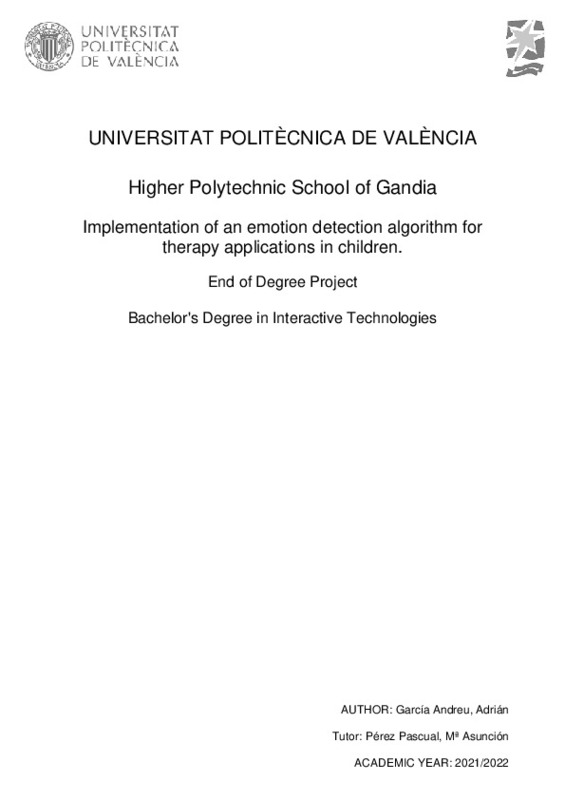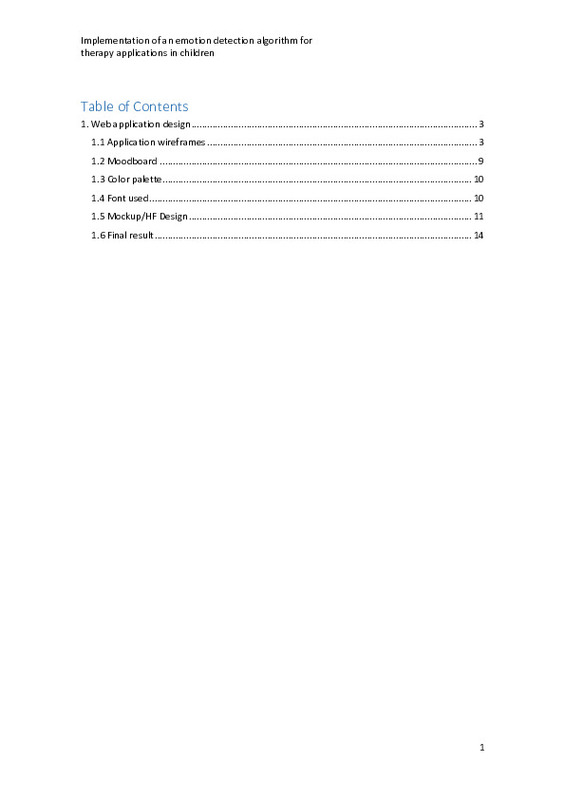JavaScript is disabled for your browser. Some features of this site may not work without it.
Buscar en RiuNet
Listar
Mi cuenta
Estadísticas
Ayuda RiuNet
Admin. UPV
Implementation of an emotion detection algorithm for therapy applications in children.
Mostrar el registro sencillo del ítem
Ficheros en el ítem
| dc.contributor.advisor | Pérez Pascual, Mª Asunción
|
es_ES |
| dc.contributor.author | García Andreu, Adrián
|
es_ES |
| dc.date.accessioned | 2022-11-07T09:19:28Z | |
| dc.date.available | 2022-11-07T09:19:28Z | |
| dc.date.created | 2022-09-21 | |
| dc.date.issued | 2022-11-07 | es_ES |
| dc.identifier.uri | http://hdl.handle.net/10251/189220 | |
| dc.description.abstract | [ES] La detección de emociones a través de las expresiones faciales es una técnica que está siendo utilizada en las sesiones de terapia con niños autistas. En algunos casos, se utilizan robots que son capaces de detectar las emociones de los niños y clasificarlas para realizar un estudio posterior. Se tiene constancia de que los niños con trastorno del espectro autista se sienten más seguros interactuando con robots ya que son más predecibles y menos complejos que las personas. Objetivos El objetivo principal del proyecto es: - Implementar un conjunto de aplicaciones para detectar emociones a partir del análisis facial Como objetivos secundarios se pretende: - Mostrar los resultados del análisis de la forma más adecuada para que los profesionales puedan explotarla lo mejor posible - Verificar la identidad del niño a partir de un análisis facial - Clasificar las emociones del niño correctamente - Lograr la predicción de emociones Tecnologías: Se utiliza la librería de reconocimiento facial Deepface. Se trata de un proyecto de código abierto, proporcionado por el MIT. La librería utiliza Python como lenguaje de programación. Se utilizarán diferentes modelos de reconocimiento facial (VGG-Face, Google FaceNet, OpenFace, Facebook DeepFace, Deep ID¿) con la finalidad de compararlos y establecer qué modelo ofrece mejor rendimiento para la aplicación. Raspberry Pi junto con una cámara de video Kinect, verificando que relación cámara/entorno puede ofrecer un resultado adecuado. Por otro lado, se utilizará un sistema web con diferentes tecnologías (HTML5, PHP, JavaScript, etc) para guardar la información de las sesiones, realizar el procesado posterior a estas y mostrar los resultados a los profesionales. | es_ES |
| dc.description.abstract | [EN] The detection of emotions through facial expressions is a technique that is being used in therapy sessions with autistic children. IRobots are able of detecting children's emotions and classifying them for further study. It is known that children with autism spectrum disorder feel safer interacting with robots as they are more predictable and less complex than people. Objectives The main objective of the project is: - Implement a set of applications to detect emotions from facial analysis As secondary objectives it is intended: - Show the results of the analysis in the most appropriate way so that professionals can exploit it as best as possible - Verify the identity of the child from a facial analysis - Classify the child's emotions correctly - Achieve the prediction of emotions Technologies: The Deepface facial recognition library is used. It is an open source project, provided by MIT. The library uses Python as its programming language. Different facial recognition models will be used (VGG-Face, Google FaceNet, OpenFace, Facebook DeepFace, Deep ID...) in order to compare them and establish which model offers the best performance for the application. Raspberry Pi together with a Kinect video camera, verifying that the camera/environment relationship can offer an adequate result. On the other hand, a web system with different technologies (HTML5, PHP, JavaScript, etc.) will be used to save the information of the sessions, carry out the subsequent processing and show the results to the professionals. | es_ES |
| dc.format.extent | 50 | es_ES |
| dc.language | Inglés | es_ES |
| dc.publisher | Universitat Politècnica de València | es_ES |
| dc.rights | Reserva de todos los derechos | es_ES |
| dc.subject | Aplicación Web | es_ES |
| dc.subject | Terapia infantil | es_ES |
| dc.subject | Algoritmo | es_ES |
| dc.subject | Emociones | es_ES |
| dc.subject | Procesamiento de información | es_ES |
| dc.subject.classification | TECNOLOGIA ELECTRONICA | es_ES |
| dc.subject.other | Grado en Tecnologías Interactivas-Grau en Tecnologies Interactives | es_ES |
| dc.title | Implementation of an emotion detection algorithm for therapy applications in children. | es_ES |
| dc.title.alternative | Implementació d'un algorisme de detecció d'emocions per a aplicacions de teràpia en xiquets | es_ES |
| dc.title.alternative | Implementación de un algoritmo de detección de emociones para aplicarlo en terapia de niños | es_ES |
| dc.type | Proyecto/Trabajo fin de carrera/grado | es_ES |
| dc.rights.accessRights | Abierto | es_ES |
| dc.contributor.affiliation | Universitat Politècnica de València. Departamento de Ingeniería Electrónica - Departament d'Enginyeria Electrònica | es_ES |
| dc.contributor.affiliation | Universitat Politècnica de València. Escuela Politécnica Superior de Gandia - Escola Politècnica Superior de Gandia | es_ES |
| dc.description.bibliographicCitation | García Andreu, A. (2022). Implementation of an emotion detection algorithm for therapy applications in children. Universitat Politècnica de València. http://hdl.handle.net/10251/189220 | es_ES |
| dc.description.accrualMethod | TFGM | es_ES |
| dc.relation.pasarela | TFGM\152529 | es_ES |
Este ítem aparece en la(s) siguiente(s) colección(ones)
-
EPSG - Trabajos académicos [4726]
Escuela Politécnica Superior de Gandia







